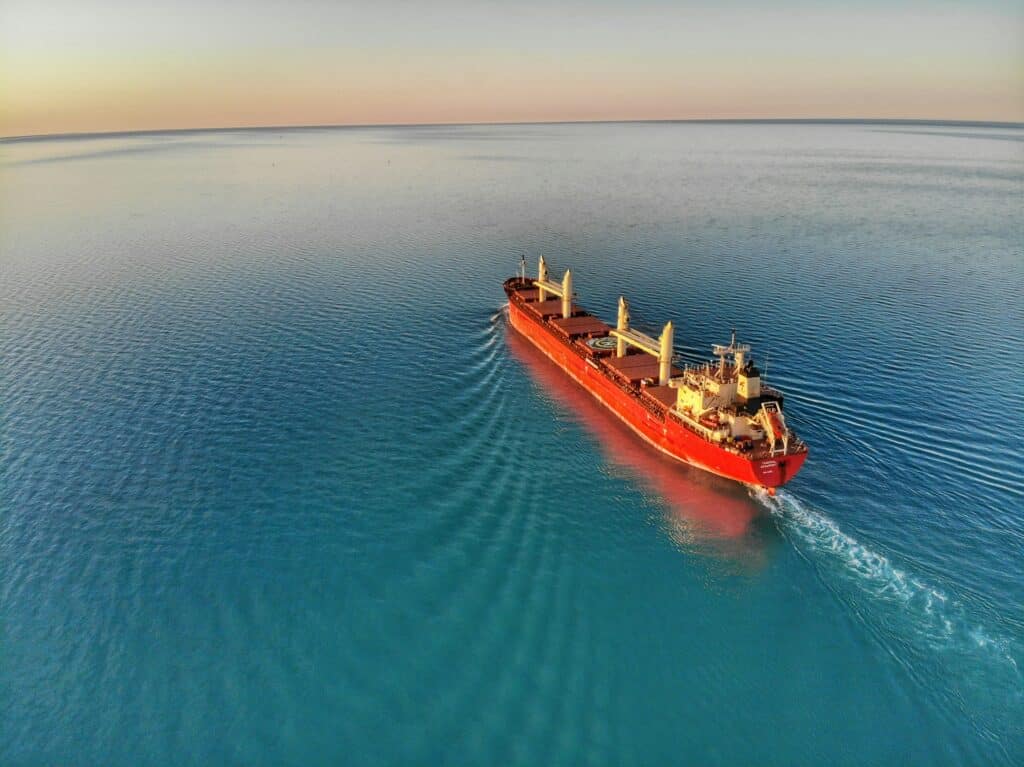Methane emissions in the global and EU maritime policies – what is changing and for whom?
This is the first installment of the Topic of the Month: Taking stock of methane emissions regulation
The decarbonisation of maritime transport has been a topic of the recent webinar organised jointly by the Florence School of Regulation and the Oxford Institute for Energy Studies.
The first instalment of the Topic of the Month series on methane emissions looks into how the global and European regulatory frameworks for maritime transport are changing and how they may affect methane emissions mitigation in this sector.
Maritime transport accounts for ~3% of global anthropogenic greenhouse gases (GHGs), mostly CO2, methane and nitrous oxide. The sector’s global regulator, the International Maritime Organisation (IMO) adopted a revised GHG strategy setting a net-zero GHG emissions from international shipping close to 2050 in 2023. The strategy also set indicative targets for 2030 (to reduce total annual GHG emissions from international shipping by at least 20%, striving for 30% compared to 2008) and 2040 (to reduce total annual GHG emissions from international shipping by at least 70%, striving for 80% compared to 2008). The decarbonisation of the sector will not be an easy task, as over 90% of energy used in the sector is fossil fuel-based, and the alternative fuels, which has significantly increased over the last few years is Liquefied Natural Gas (LNG).1 The rise of LNG increased the scrutiny over the emissions, including methane slip, associated with the use of this fuel.2,3
By 2025, IMO expects to finalize mid-term measures to achieve revised decarbonization objectives including a marine fuel standard and GHG pricing mechanism. While the IMO does not regulate methane emissions directly, methane and nitrous oxide are part of the LCA Guidelines and may be incorporated under the mid-term measures. These new policies will be subject to a discussion at the next IMO’s Marine Environment Protection Committee (MEPC) meeting on 18-22 March 2024.
As of 2024, maritime transport emissions have been incorporated under the European Union cap-and-trade program – the Emissions Trading System (EU ETS).4 As a result, shipping companies using European ports have to monitor and report their emissions and purchase and surrender EU allowances (EUAs) for each tonne of reported carbon dioxide (CO2) emissions. From 1 January 2026, this obligation will be extended to two short-lived GHGs – methane (CH4) and nitrous oxide (N2O). In parallel, the EU has finalised the Fit for 55 package legislation, including FuelEU maritime regulation, creating demand for alternative marine fuels5 and the EU Methane regulation covering emissions from imported energy6, including Liquefied Natural Gas (LNG), which should be adopted in the coming months.
These regulatory developments have significant implications for the shipping sector, methane mitigation, and the LNG industry.
Shipping under growing decarbonisation pressure
Recent regulatory developments at the IMO and EU level have moved the maritime sector into the spotlight of global decarbonisation efforts. The level of ambition in the revised 2023 IMO GHG Strategy surpassed the expectations of IMO observer organisations, unlikely to happen without the EU challenging to IMO on carbon pricing scheme with its Fit for 55 measures.7 The EU ETS has a direct and imminent regulatory and monetary impact, creating incentives for the European shipping companies to decarbonise and rewarding proactive operators who can credibly present the GHG emissions associated with their operations. However, it is unlikely that the ETS alone will be enough to shift the consumption to renewable fuels, such as methanol, hydrogen or ammonia.
The FuelEU regulation is likely to increase the demand for renewable marine fuels, by increasing the reduction targets for the GHG intensity of energy used on board ships as from 1 January 2025 (2% below the reference value of 91.16 grams of CO2e/MJ in 2025, 6% in 2030, 31% in 2040 and 80% in 2050) and introducing measures to encourage the use of renewable fuels of nonbiological origin (RFNBO). In contrast to the EU ETS, FuelEU regulation adopted well-to-wake approach, similarly to the IMO’s strategy.
One of the key uncertainties up to 2030 is whether the IMO will adopt consistent, comprehensive and stricter GHG regulations. If yes, the EU ETS and FuelEU Regulation will be revised, if not or if the adopted policies are not ambitious enough, the ETS may be extended to cover all emissions associated with voyages starting and ending outside the EU, which are currently only partially covered.
Methane in EU policies: how to make MRV more consistent?
As of 2026/7, methane emissions will be regulated under two different policy instruments in the EU – market-based ETS and the EU Methane Regulation, covering emissions associated with the extraction, transportation and end-use of fossil fuels – oil, gas (pipeline and LNG) and coal. Both policies set out separate rules for Monitoring, Reporting and Verification (MRV) of methane emissions. This situation creates some inconsistencies as to how methane is regulated in the EU and with the EU ambitions outlined in the 2020 EU Methane Strategy, particularly with regard to emissions associated with energy imports. In particular: 1) which methane emissions are regulated and which are not, 2) how are methane emissions monitored, reported and verified, 3) which Global Warming Potential values are used to calculate CO2e.
The first contradiction refers to the scope of policies. The proposed EU Methane Regulation does not directly cover emissions associated with LNG shipping (art. 1), which are incorporated under the EU ETS. However, ETS covers mostly the emissions associated with the incomplete combustion of LNG, methane slip. As a result, some LNG-related sources are likely to remain unregulated e.g. emissions arising during LNG loading and unloading, boil-off gas (BOG) emissions (if BOG is not routed as fuel via a fuel gas supply system or reliquefied onboard and reinjected in the cargo tanks) as well as fugitives and vents arising during the LNG shipping, unless they will be covered under the EU Methane Regulation’s import requirements, which without having the final version of the EU Methane Regulation adopted is still subject to a debate.8
The second contradiction refers to the inconsistency in quantification and verification of methane emissions. The Methane Regulation places the focus on direct emission measurements, and measurement-based emission factors, in line with the OGMP2.0 Level 4 and 5 quantification. In contrast, the EU MRV Maritime Regulation is mostly based on a calculation-based approach and sets default emission factors (EFs) for the methane slip calculation, providing no incentives for choosing direct emission measurements instead of emission calculation.
This discrepancy can be explained by the fact that CO2 accounts for the vast majority (>90%) of emissions in shipping and these emissions can reasonably be calculated using engineering methods (by multiplying fuel consumption and CO2 emission factors). The uncertainty in CO2 calculations is much less pronounced relative to methane, which in turn constitutes a material GHG in the natural gas supply chain. However, these assumptions may not always be correct,9 highlighting the necessity for more direct measurement studies to better understand shipping emissions profile2 and raising questions over the uncertainty of methane estimations under the EU ETS, given the system’s direct monetary impact.
The last contradiction refers to the Global Warming Potential values used for CO2e calculations. While the over 100 year horizon is consistently used under the Fit for 55 legislation, some differences exist in the choice of specific values. For example, methane emissions will be multiplied: by 25 under the FuelEU maritime regulation (as defined in Directive (EU) 2018/200110, paragraph 4 of Part C of Annex V) and by 28 under the EU ETS, based on the EU MRV maritime regulation and Delegated acts (as defined in Annex to Commission Delegated Regulation (EU) 2020/1044)11.
The impact on LNG as a marine fuel
The ETS data management services company, OceanScore, estimated the EU ETS compliance cost, based on 82.7m EU Allowances which would have been needed for voyages to from and between European ports in 2022, at €6.5bn, assuming the price of €78 per EUA/tCO2.12 This would have translated into the average cost of complying with the EU ETS by 2024 standards amounting to about 3.25% of the freight cost, according to Argus.13 While it creates a “significant financial exposure” for the shipping industry, the reason for concern is not necessarily the ETS compliance cost itself, but rather ETS price volatility alongside the risk of non-compliance fines.13 In theory, shipowners could seek reimbursement by the entity responsible for the fuel purchase and/or the ship’s operation under the EU ETS rules. Yet, it is still not clear how it will work in practice and some shipowners have already declared their plans to pass the costs over to ship charterers.
The risk is even higher for ships emitting methane and nitrous oxide. As these emissions will be multiplied by 28 and 265, respectively, to calculate CO2e. Shipping companies with LNG-fuelled vessels in their fleet will need to pay more attention to robust monitoring, reporting and verification of their GHG emissions. While LNG has been presented as an alternative due to lower CO2 emissions upon combustion, the new EU shipping regulations create a certain disadvantage for LNG. The industry related to LNG shipping is already responding to this challenge by investing in: larger and more efficient fleet, 2 stroke engines characterised by lower methane slip, as well as onboard reliquefaction units to deal with BOG and increasingly looking into future technologies like Carbon Capture and Storage (CCS).14
It is still to be seen if it will be sufficient to maintain the uptake of LNG as a marine fuel on an upward trend, and how regulatory changes in Europe may impact LNG ship order book. For instance, over the coming five years, the global LNG carrier fleet is projected to add 303 vessels to the 615 vessels existing in 2022.14 Regulatory changes in Europe and the revised IMO GHG strategy (still lacking binding IMO policies implementing mid-term measures) may not necessarily reverse, but are likely to reduce the growth in the LNG carrier fleet going forward. For the existing fleet, the regulation may widen the price differential between vessels using different propulsion systems, as charterers will be likely to demand more efficient technologies.14
References:
- DNV (2023). Energy Transition Outlook 2023 – Maritime Forecast to 2050.
- Balcombe, P., Heggo, D.A., and Harrison, M. (2022). Total Methane and CO2 Emissions from Liquefied Natural Gas Carrier Ships: The First Primary Measurements. Environ. Sci. Technol. 56, 9632–9640. 10.1021/acs.est.2c01383.
- Comer, B., Beecken, J., Vermeulen, R., Sturrup, E., Paschinger, P., Osipova, L., Gore, K., Delahaye, A., Verhagen, V., Knudsen, B., et al. (2024). Fugitive and Unburned Methane Emissions from Ships (FUMES): Characterizing methane emissions from LNG-fueled ships using drones, helicopters, and onboard measurements (The International Council on Clean Transportation (ICCT)).
- Directive 2003/87/EC of the European Parliament and of the Council of 13 October 2003 establishing a system for greenhouse gas emission allowance trading within the Union and amending Council Directive 96/61/EC (Text with EEA relevance). URL: <http://data.europa.eu/eli/dir/2003/87/2023-06-05/eng> (2023).
- Regulation (EU) 2023/1805 of the European Parliament and of the Council of 13 September 2023 on the use of renewable and low-carbon fuels in maritime transport, and amending Directive 2009/16/EC (Text with EEA relevance). URL: <http://data.europa.eu/eli/reg/2023/1805/oj/eng> (2023).
- Council (2023). Climate action: Council and Parliament reach deal on new rules to cut methane emissions in the energy sector. https://www.consilium.europa.eu/en/press/press-releases/2023/11/15/climate-action-council-and-parliament-reach-deal-on-new-rules-to-cut-methane-emissions-in-the-energy-sector/.
- Yarrow-Wright, S. (2022). Throwing Down the Gauntlet: The European Challenge to IMO on Carbon Pricing. Energy Exchange. https://blogs.edf.org/energyexchange/2022/12/08/throwing-down-the-gauntlet-the-european-challenge-to-imo-on-carbon-pricing/.
- OGMP2.0 (2023). Guidance document: LNG Shipping. URL: <https://ogmpartnership.com/wp-content/uploads/2023/06/LNG-Shipping-TGD_SG-Approved.pdf>.
- Roman-White, S.A., Littlefield, J.A., Fleury, K.G., Allen, D.T., Balcombe, P., Konschnik, K.E., Ewing, J., Ross, G.B., and George, F. (2021). LNG Supply Chains: A Supplier-Specific Life-Cycle Assessment for Improved Emission Accounting. ACS Sustainable Chem. Eng. 9, 10857–10867. 10.1021/acssuschemeng.1c03307.
- Consolidated text: Directive (EU) 2018/2001 of the European Parliament and of the Council of 11 December 2018 on the promotion of the use of energy from renewable sources (recast) (Text with EEA relevance). URL: <https://eur-lex.europa.eu/legal-content/EN/TXT/?uri=CELEX%3A02018L2001-20220607> (2022).
- Commission Delegated Regulation (EU) 2020/1044 of 8 May 2020 supplementing Regulation (EU) 2018/1999 of the European Parliament and of the Council with regard to values for global warming potentials and the inventory guidelines and with regard to the Union inventory system and repealing Commission Delegated Regulation (EU) No 666/2014 (Text with EEA relevance). URL: <https://eur-lex.europa.eu/legal-content/GA/TXT/?uri=CELEX%3A32020R1044> (2020).
- Hellenic Shipping News Worldwide (2023). Shipping companies must manage financial balancing act on EU ETS tightrope, says OceanScore. Hellenic Shipping News Worldwide. https://www.hellenicshippingnews.com/shipping-companies-must-manage-financial-balancing-act-on-eu-ets-tightrope-says-oceanscore/.
- Leonard Fisher-Matthews (2023). EU ETS “poses exposure issues” to shipping.
- IGU (2023). 2023 World LNG Report (International Gas Union).







